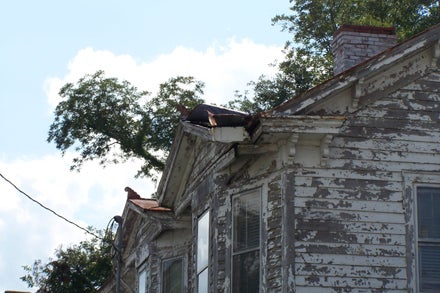Investment needed: Houses’ fate often depends on money
Published 8:18 pm Thursday, March 19, 2015

FILE PHOTO | DAILY NEWS
SAVED: The Potts-Burgaw-Duke House is proof that a properly motivated owner can transform a run-down house into a residential showcase.
When it comes to deteriorating houses in Washington, especially in the city’s historic district, some people view them as structures that need saving, while others see them as eyesores that bring down property values in the neighborhood.
Sometimes such a house is “saved” at the last minute. Other times, such a house is condemned and torn down.
Several years ago in an effort to keep houses and other structures that may have some historic significance, the city adopted its demolition-by-neglect ordinance. The ordinance, which applies only in the historic district, is aimed at preventing structures from deteriorating because property owners neglect to properly maintain them. Such a home, especially in a historic district, can lead to the values of adjacent properties declining.

FILE PHOTO | DAILY NEWS
NEGLECTED: This is how the house at 312 Water St. looked in the autumn of 2014 as it awaited being sold at auction on the Beaufort County Courthouse steps.
The demolition-by-neglect ordinance is used by the city to keep historically and/or architecturally significant properties from deteriorating to the point they cannot be saved by rehabilitation measures.
By saving such properties and making sure they are restored, which increases their values, the city stands to take in more property taxes on the rehabilitated properties than it would take in if the properties were not repaired or they were eventually demolished, removing them from the tax rolls.
There is a difference in purpose between the demolition-by-neglect ordinance and condemning a structure that does not meet minimum housing codes, according to John Rodman, the city’s director of community and cultural resources.
“State statute gives local government the ability to create an ordinance for historic structures — a demolition-by-neglect ordinance. A demolition-by-neglect ordinance refers only to historic structures,” Rodman said. “It has to be a national, registered district, a local district. When we talk about West Fifth Street, then we’re talking about minimum housing code.”
Rodman addressed the differences.
“Some people neglect their homes so much that, eventually, … the only alternative you have left is demolition. We want to catch them before it reaches that point. So, that’s what the … ordinance is for,” Rodman said.
The ordinance’s goal is not necessarily make the house habitable but to stabilize it so it doesn’t deteriorate further, he said.
“Just about every house is fixable, if you have enough money,” Rodman said.
If a homeowner in the historic district can prove it would be a financial hardship to make needed repairs to his or her house, the city is willing to provide assistance under certain conditions, Rodman said.

FILE PHOTO | DAILY NEWS
GONE: Extreme deterioration of this house at 507 W. Second St. eventually led to its demolition after several attempts by the city to sell the house so it could be restored fell through.
Perhaps one of the best examples of a deteriorating house being preserved is the home of Don Stroud, a former chairman of the city’s Historic Preservation Commission. The Potts-Burgaw-Duke House, about 150 years old, was featured in a 2013 edition of Washington the Magazine.
Taking 23 years to accomplish, the house was restored room by room. The transformation from “crack house” to opulent residence preserved many of the house’s features, but not all of them could be save.
Usually, a house is condemned because it poses a threat to the public’s safety and/or does not meet minimum housing and fire codes. Before a house is condemned and a demolition contract awarded, the city must follow specific procedures that include informing the property owner of the house’s deficiencies, outlining remedies to address those deficiencies and providing a period of time for addressing the problems. Those procedures also spell out the appeals process a property owner must follow should he or she want to challenge the city’s findings.
Similar procedures apply in demolition-by-neglect cases, Rodman said.
In recent years, the city has condemned and awarded demolition contracts for houses at 221 W. Fifth St., 309 W. Fifth St. and 507 W. Second St. In the case of the house at 507 W. Second St., several attempts to save the house for rehabilitation did not work, including a plan to sell the house using the upset-bid process.
In late 2013, the city rescinded the demolition order issued for the house at 312 Water St. A little more than a year ago, the City Council took action that spared the house from the wrecking ball.
At its Oct. 7, 2013, meeting, the City Council directed the city manager and city attorney to pursue liens and penalties the city had imposed against that property. It also rescinded a demolition order it previously issued in regard to the property. The property’s out-of-state owner rejected all notices sent by the city. The property was condemned under the city’s demolition-by-neglect ordinance.
Previously, the city hired St. Clair Trucking to demolish the structure. During the delay in demolition, the city’s Historic Preservation Commission, as is its obligation, sought alternatives to the demolition process. Finding those alternatives included discussions with Preservation North Carolina, which was seeking a buyer for the property and performing maintenance on the property.
The Historic Preservation Commission recommended the City Council rescind its demolition order and either spend money (which would result in a lien on the property) to stabilize the house or immediately impose maximum demolition-by-neglect fines on Henry until he stabilizes the house. A petition with the names of people interested in having the demolition order rescinded was presented to the commission. Preservationists wanted the city to provide an opportunity for someone to come forward with a plan to rehabilitate the house.
“It was obviously past the point, but we had homeowners who were willing to make that investment,” Rodman said.
In October 2014, the house sold by way of auction on the steps of the Beaufort County Courthouse. Once the city recouped its liens against the property, the remainder of the money went to the property owner.
“The (new) folks who came in had a plan. They had to get a structural engineer to come in to make sure the home could be stabilized and fixed. It was. They’ve come in and made that investment and started to fix it up. So, they were willing to make that investment.”





